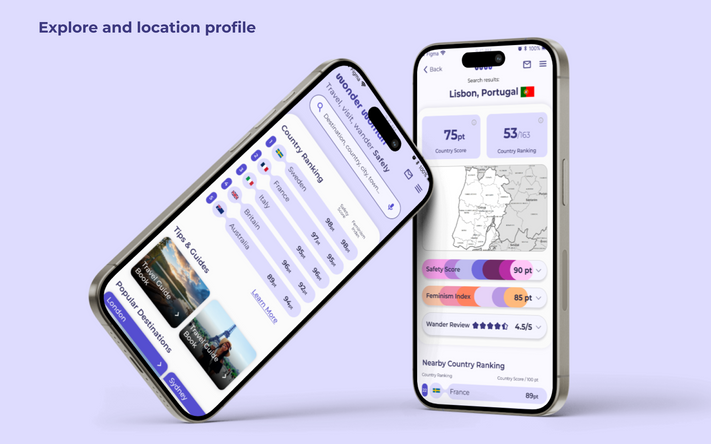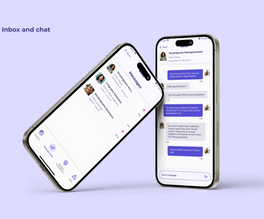wander woman
Master thesis project "Wander Woman," which addresses the safety concerns of female travelers worldwide. Backed by alarming statistics revealing the heightened risks faced by women travelers, the project aims to empower and promote gender equality through data-driven insights and technology. Wander Woman introduces innovative metrics like the Safety Score and the Feminism Index, enabling users to assess safety conditions and evaluate a country's commitment to gender equality before embarking on their travels. By leveraging data analysis, machine learning methodologies, and user reviews, Wander Woman strives to provide women travelers with the information and tools they need to navigate safely and confidently, ultimately fostering positive change in women's travel safety and gender equality globally.
Tools Used: Figma
Project
Objective: The goal was to create an intuitive, robust platform to provide solo female travelers with real-time safety information and a network for support and connection, all while fostering an inclusive environment that champions women's freedom and adventure in travel.
Research and Analysis: Extensive market research, user surveys, and data analysis were conducted to understand the unique challenges faced by solo female travelers. This research shaped the app's design, ensuring that features like the Safety Score and SOS Alarm were grounded in actual user needs and preferences.
Design and Development: The design process centered on creating an engaging user experience with a focus on simplicity and ease of use. Challenges included ensuring reliable real-time data integration and creating a responsive interface that felt both personal and secure.


Key Features
-
Safety Score: Provides a location-based safety assessment using current data and user feedback.
-
Feminism Index: Evaluates travel destinations based on gender equality metrics.
-
Wander Pal: Connects users for shared travel experiences.
-
Nearby Wanderer: Helps users find companions and activities in their vicinity.
-
SOS Alarm: Offers a one-tap emergency alert system connecting users with local services.
Safety Score
This index quantifies the level of safety for women in each country, using data on feminist laws, femicides, and assaults, enabling informed decisions for travel planning and promoting safer experiences.
This score is a reliable guide, enabling women travelers to make informed decisions and ensuring their well-being during their journeys.


Feminism Index
This index assesses the level of gender equality and women's rights in each country. This index would consider factors such as laws protecting women's rights, access to education and healthcare, and representation in government and the workforce.
The index would be regularly updated to reflect any changes in policies or the social climate of each country.
User flow

In my design process, we prioritized defining user flows before working on sketches, wireframes, and mockups. Firstly, it enabled us to visually map out how users would navigate the platform, ensuring a user-friendly experience. Secondly, it emphasized our commitment to a user-centered design.
These user flows acted as comprehensive roadmaps, outlining the step-by-step pathways for users to achieve essential tasks within the app. They formed the cornerstone of our user-centered design journey, streamlining our design process. By developing these user flows, we ensured the effective implementation of features, optimized the user experience, and seamlessly integrated these enhancements into the overall design. The features were put in context by “actions” representing a situation where the user would use the platform.
Sitemap
To access the hardware conditions for the features to be functional, and considering that there are interactions designed to be used during the trip is more probable that the user will have access to their phone more than other devices this is why the main platform will be designed for mobile devices. The app will have to access the user's location, the audio and video recording system, and the contact list on the phone. These elements are key so the Sos Alarm with the Guardians feature can work properly.
That’s why, in the image on the side, we present the information architecture of mobile and web versions, although the design of the prototype will focus on the mobile platform.

Sketches
The sketching phase was a crucial step in our design process. It was the blueprint, visualizing our conceptual ideas into tangible frames. Before diving into the design details, we started sketching to maintain flexibility and prioritize a user-centric approach.
These sketches were not mere illustrations; they were the architectural framework of our application. They enabled swift ideation, enabling iterative improvements of the design concepts. Our focus revolved around enhancing usability and, most importantly, addressing the specific needs of our users.

Low-Fidelity mock-ups
Low-fidelity mockups were a vital part of the Wander Woman project's design phase. These simple mock-ups and wireframes helped refine ideas, allowing quick iterations and user-centric design decisions. Focusing on functionality over aesthetics ensured a strong user experience foundation. See Figure 1, and to see the diagram on a bigger scale it can be found in Appendix D.

Ui design - design system
Design and style: aestheticsThe platform is envisioned as an integral part of travel planning, aiming for a design that is not overtly political or excessively feminist but seamlessly integrates data and aligns with a woman's lifestyle. While elements inspired by feminism and femininity have been incorporated into the design, they were consciously chosen to tone down any political undertones. This decision stems from the desire to create a platform that feels welcoming and accessible to women of all ages, races, and nationalities. The platform must not discriminate based on political beliefs or socioeconomic status. At its core, this platform is about safety, a fundamental right that every woman worldwide should be able to access and benefit.
Feminist aesthetics had a witty expression since, as women looked at their peers, they found themselves and the other females marginalized in a male-dominated world. In 1985, a group of women called the Guerrilla Girls used sarcasm and humor to express themselves, convey information, provoke discussion, and show that feminists can be funny, as stated on their website. Publishing witty posters with humor and irreverence to express the sentiments as a means to defy the self-proclaimed "conscience culture" (Brand, 2006, 259-260).
The first aesthetic used was oriented to provoke a comical, humorous, or witty perception of the platform, as seen in Appendix E. However, after doing the user research, it was defined that with the broad age gap, we found among the users, choosing a more composed general aesthetic would be preferable to create a more approachable platform that felt welcoming and accessible to all users. Also, since safety is a natural and serious issue, showing a more composed visual made more sense.

High-fidelity Mockups
Wander Woman's interface is designed with cleanliness, modernity, and visual appeal, aligning with its mission to provide remarkable assistance to female travelers. The app's primary color, a calm violet, evocates trust and reliability, while its design incorporates data visualization elements for user-friendly access to all features. This design reinforces the platform's commitment to safety and empowerment, ensuring users can easily navigate and trust the app for their travel needs.






